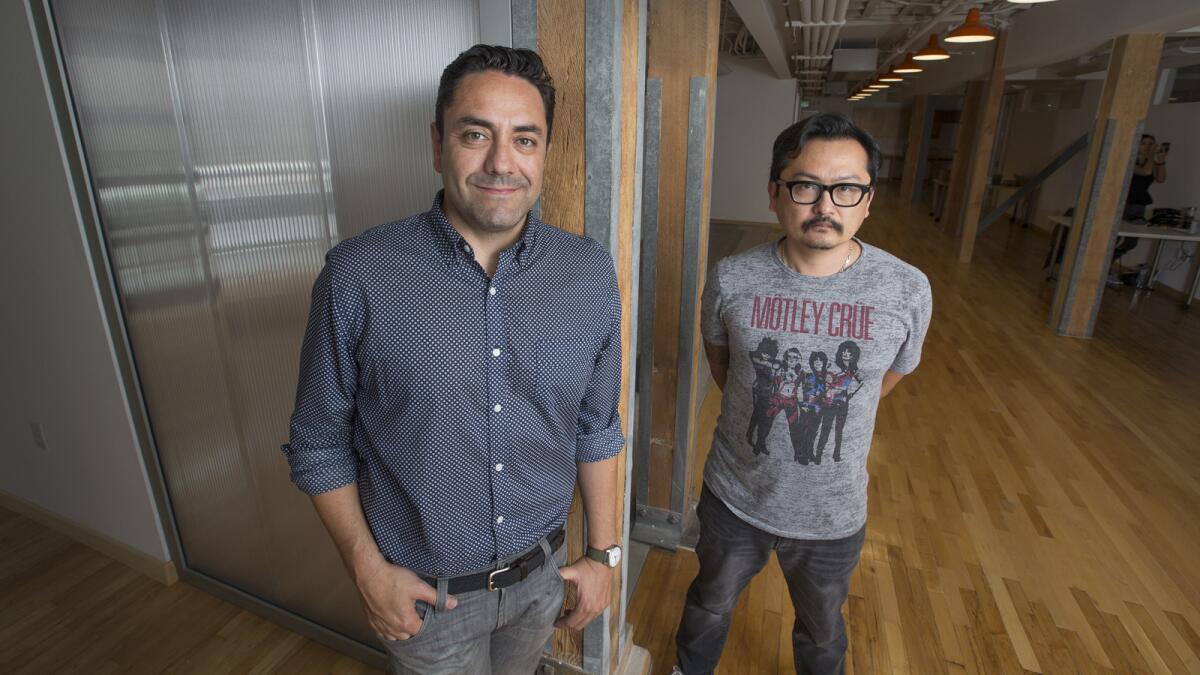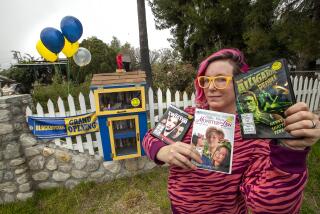Movie trailer makers multiply as online viewing of previews soars

Soda Creative, based in downtown Los Angeles, is one of several companies that have sprouted up to take advantage of studios’ appetite for targeted marketing. Above, owner Jaime Gamboa, left, and business partner Jaehoon Oh.
Movie trailers have become their own kind of blockbusters.
Hollywood studios collectively spent $3.16 billion last year on U.S. marketing efforts to draw people to the theaters in the face of competition from new entertainment options, according to Nielsen.
The struggle to reach the mass audience has given rise to a diverse industry of producers that cuts feature films into bite-sized appetizers. About 15 years ago, there were only a dozen or so companies distilling motion pictures down to 21/2-minute previews. Now there are more than 100.
Fueling this growth has been an explosion in viewing online, where previews can generate as much buzz as the films themselves. People have watched more than 35 million hours of movie trailers on YouTube so far in 2015, up 90% from the same period last year.
“For us, it’s a heyday of trailer-making,” said David Stern, whose 10-year-old company, Create Advertising Group, has worked on campaigns for “Fantastic Four,” “Minions” and “Avengers: Age of Ultron.”
The rise of trailer companies is largely due to technology. New digital advances for filmmakers have made it easier and cheaper for aspiring trailer cutters to get started on their own, and the reach of YouTube means a bigger audience than ever.
Established players such as Trailer Park, Mark Woollen & Associates and Create Advertising have had their eyes on the broader market for years. But some start-ups have gained a foothold by appealing to specific demographic groups.
Soda Creative, based in the hip Arts District of downtown Los Angeles, is one of the companies that have sprouted up to take advantage of studios’ appetite for targeted marketing. Owner Jaime Gamboa has made a specialty of the burgeoning Latino market that has become increasingly important to Hollywood and driven the success of huge films such as “Furious 7.”
Stunning photos, celebrity homes: Get the free weekly Hot Property newsletter
He and business partner Jaehoon Oh, who started Soda in 2013, try to amplify parts of the movie that will appeal to Latinos without pigeonholing them. Their “Guardians of the Galaxy” commercial for Univision, for example, highlighted the Disney superhero movie’s action and swagger, not its offbeat humor and 1970s pop music.
Disney also recruited Soda for its feel-good movie “McFarland USA,” about a white PE coach who leads a team of Latino cross-country runners. Disney desired a more “culturally rich” feel for the drama’s second trailer, Gamboa said.
It wanted a different song to play over the footage, replacing the U2 track used in the first trailer. Gamboa’s team and Disney ultimately landed on a song from Colombian rocker Juanes.
“The way other major agencies were approaching the Hispanic market was, to be frank, very archaic,” said Gamboa, 41, who is Mexican American. “We’re not coming at it from the perspective of ‘I’m Hispanic, so I know all about Hispanics.’ We’ve been involved in the research.”
The focus on Latinos appears to be working.
Gamboa’s staff has more than doubled to 12 full-time employees in the last year, and he says his revenue is growing at an annual rate of 40% to 44%. The company this month moved to a 4,000-square-foot space from a cramped temporary office.
The audience for trailers is not just diverse, it’s hungry, experts say. The explosion of online video has helped make trailer release dates into events that get their own promotional push. Studios increasingly hype teaser trailers that come out ahead of the full versions, and announce when they’ll unveil each new video to keep the audience interested for months leading up to opening weekend.
Websites such as YouTube have become the go-to place to view movie ads, especially for young people who aren’t trekking to the multiplex as often as their parents did. The second official teaser for “Star Wars: The Force Awakens” racked up 88 million online views on its first day alone, Disney said in April.
“The marketing of the marketing has become a prime secret weapon,” said Craig Murray, whose Los Angeles firm mOcean has helped with campaigns for Marvel’s “Ant-Man” and Warner Bros.’ “American Sniper.”
There are risks to flooding the Internet with movie ads. Trailers can bomb, just like the movies they sell.
Fans have long complained about pre-rolls that go on too long, give away too much of the plot or mislead the audience. One filmgoer in 2011 sued the distributor of the Ryan Gosling movie “Drive,” contending the marketing suggested it would be similar to the “Fast & Furious” films. She lost her case.
Trailers have been mocked for their familiar formulas and cliches — think “In a world …” voice-overs and endless “from the makers of …” roll calls. A common complaint: Why see the movie, when all the best jokes are in the preview?
In today’s culture of social media and fanboy websites, trailers are parsed and criticized without mercy. The “Batman v. Superman: Dawn of Justice” trailer, released in April shortly after a low-quality version leaked, met with decidedly mixed reviews.
“You can have backlash, for sure,” said Fandango Chief Content Officer Sandro Corsaro, who oversees trailers for the online ticket seller. “The ante has definitely been upped.”
But sometimes it works.
Disney sparked a frenzy over its 88-second preview for the next “Star Wars” movie last year by announcing it would run in just 30 North American theaters on Black Friday. The Burbank studio unveiled the preview online the same day to tens of millions of views over the holiday weekend, sparking wide excitement about the franchise reboot that debuts in December.
And the official trailers from the studios are only a part of the boom. Fans upload “reaction” videos by the thousands, giving their first takes on the previews.
For the summer hit “Jurassic World,” fan uploads earned more than twice as many views as the videos Universal Pictures put up, according to the video technology firm Zefr, which helps entertainment companies track and analyze clips on YouTube.
“It’s all been for the benefit of the marketers, because they can harness the power of the fans,” said Zefr co-founder Rich Raddon.
Warner Bros. this month tried to keep a lid on the Comic Con trailer for the super-villain movie “Suicide Squad.” But in the face of leaks, the Burbank movie giant begrudgingly relented and released the footage on the Internet.
Studios are willing to spend $50,000 to $500,000 to get a trailer right.
Marketing pushes for the biggest blockbusters can start more than a year before the film’s release. Studios tap firms like mOcean and Create Advertising to come up with ideas even before the picture begins shooting, basing teaser concepts on scripts and storyboards.
The firms sometimes get complete movies to work with. But with bigger, effects-driven films, the companies tend to get piecemeal access to scenes as they’re completed. A single teaser trailer concept can take two to six months to come to fruition, as it goes through the painstaking efforts of writers, editors, voice-over actors and music supervisors.
Not everyone wants more marketing. Trailer length has been a bone of contention between theater owners and studios, as well as a source of annoyance for audiences. Last year the National Assn. of Theatre Owners put out new guidelines to clamp down on the duration of trailers and how far in advance they are shown before a film’s release.
On the other hand, trailers have proved popular enough to spawn their own awards shows. The annual Golden Trailer Awards — considered the Oscars for short attention spans — has recently given top honors to spots for “Furious 7,” “Gravity” and “Iron Man 3.” It bestows an especially dubious title, the Golden Fleece, for the best advertisement of a bad movie.
The last ceremony, held in May, played to a sell-out crowd at the Saban Theatre in Beverly Hills. The event, hosted by “Silicon Valley” actor T.J. Miller, doled out trophies for “Furious 7,” “Big Hero 6” and “Ted 2.” The Golden Fleece went to “The Giver,” and “Inherent Vice” won the Don LaFontaine Award — for best voice-over.
“People’s attention spans are shrinking,” said Evelyn Brady-Watters, who launched the Golden Trailer Awards in 1999 with her sister Monica Brady. “You can’t waste a second of the time you have in front of people.”
More to Read
From the Oscars to the Emmys.
Get the Envelope newsletter for exclusive awards season coverage, behind-the-scenes stories from the Envelope podcast and columnist Glenn Whipp’s must-read analysis.
You may occasionally receive promotional content from the Los Angeles Times.







